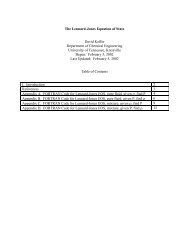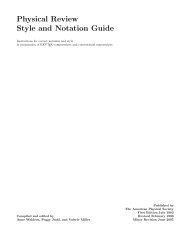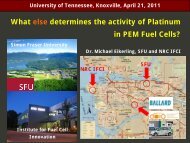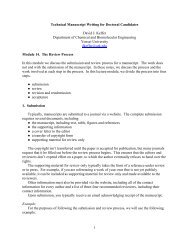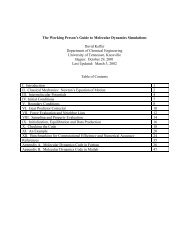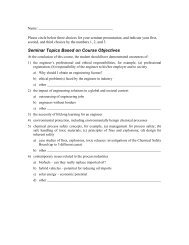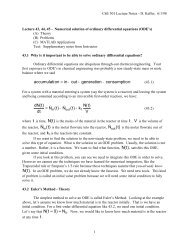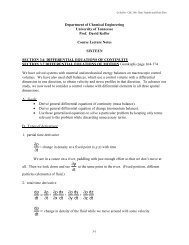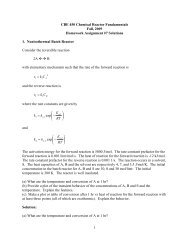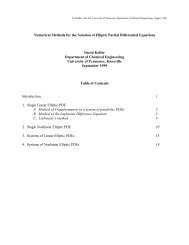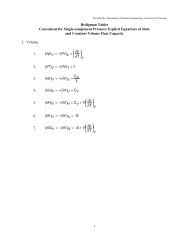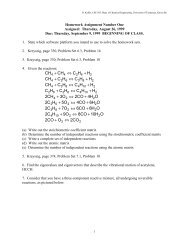A Statistical Mechanical Derivation of the van der Waals Equation of ...
A Statistical Mechanical Derivation of the van der Waals Equation of ...
A Statistical Mechanical Derivation of the van der Waals Equation of ...
Create successful ePaper yourself
Turn your PDF publications into a flip-book with our unique Google optimized e-Paper software.
Q<br />
vdw<br />
=<br />
1 ⎛V<br />
⎜<br />
N!<br />
⎝<br />
N<br />
− Nb ⎞ ⎛ NE ⎞ ⎛ − ⎞ ⎛<br />
⎜ −<br />
vdw 1 V Nb N<br />
⎟ exp<br />
⎟ = ⎜ ⎟ exp<br />
⎜<br />
3 3<br />
Λ ⎠ ⎝ k<br />
BT<br />
⎠ N!<br />
⎝ Λ ⎠ ⎝Vk<br />
N<br />
2<br />
B<br />
a ⎞<br />
⎟<br />
T ⎠<br />
(5)<br />
As always, we require <strong>the</strong> natural log <strong>of</strong> <strong>the</strong> partition function<br />
2<br />
⎛V<br />
− Nb ⎞ N a<br />
ln ( Qvdw<br />
) = −ln( N!<br />
) + N ln⎜<br />
+<br />
3<br />
⎟<br />
(6)<br />
⎝ Λ ⎠ Vk T<br />
We use Stirling’s approximation for <strong>the</strong> natural log <strong>of</strong> <strong>the</strong> factorial <strong>of</strong> a large number<br />
B<br />
2<br />
⎛V<br />
− Nb ⎞ N a<br />
ln ( Qvdw<br />
) = −N<br />
ln( N ) + N + N ln⎜<br />
+<br />
3<br />
⎟<br />
(7)<br />
⎝ Λ ⎠ Vk T<br />
The first <strong>the</strong>rmodynamic property that we will calculate is <strong>the</strong> pressure because that is what<br />
everyone associates with <strong>the</strong> <strong>van</strong> <strong>der</strong> <strong>Waals</strong> equation <strong>of</strong> state.<br />
( Q)<br />
⎛ ∂ ln ⎞ k<br />
BT<br />
a k<br />
BT<br />
a<br />
p = k<br />
BT⎜<br />
⎟ = − = −<br />
(8)<br />
2<br />
2<br />
⎝ ∂V<br />
⎠ V<br />
N , T<br />
V Vm<br />
− b V<br />
− b ⎛ ⎞<br />
m<br />
N<br />
⎜ ⎟<br />
⎝ N ⎠<br />
V<br />
where we have defined a molecular volume, V m<br />
≡ . This is <strong>the</strong> <strong>van</strong> <strong>der</strong> <strong>Waals</strong> equation <strong>of</strong><br />
N<br />
state.<br />
Now let’s <strong>der</strong>ive o<strong>the</strong>r <strong>the</strong>rmodynamic functions. We will start with <strong>the</strong> molecular<br />
Helmholtz free energy,<br />
A<br />
=<br />
⎡<br />
⎛V<br />
− Nb ⎞ Na ⎤<br />
( Q) = −k<br />
T − ln( N ) + 1+<br />
+ ⎥ ⎦<br />
A k<br />
BT<br />
= − ln<br />
N , T B ⎢<br />
ln⎜<br />
⎟<br />
(9)<br />
N N<br />
⎣<br />
⎝ Λ ⎠ Vk<br />
BT<br />
m 3<br />
The molecular internal energy is<br />
B<br />
E<br />
m<br />
=<br />
E<br />
N<br />
=<br />
k<br />
BT<br />
N<br />
2<br />
( Q)<br />
⎛ ∂ ln<br />
⎜<br />
⎝ ∂T<br />
⎞<br />
⎟<br />
⎠<br />
N , V<br />
=<br />
3<br />
2<br />
k T −<br />
B<br />
Na<br />
V<br />
=<br />
3<br />
2<br />
k T −<br />
B<br />
a<br />
V<br />
m<br />
(10)<br />
Unlike <strong>the</strong> ideal gas, <strong>the</strong> internal energy <strong>of</strong> a vdW fluid is not only a function <strong>of</strong> temperature but<br />
also a function <strong>of</strong> molar volume. The chemical potential is<br />
µ = −k<br />
⎛ ∂ ln<br />
T⎜<br />
⎝ ∂N<br />
( Q)<br />
The molecular entropy is<br />
B<br />
⎞<br />
⎟<br />
⎠<br />
T , V<br />
= −k<br />
B<br />
⎡ ⎛Vm<br />
− b ⎞<br />
T ⎢ln⎜<br />
⎟ −<br />
3<br />
⎣ ⎝ Λ ⎠ V<br />
m<br />
b 2a<br />
+<br />
− b V k T<br />
m<br />
B<br />
⎤<br />
⎥<br />
⎦<br />
(11)<br />
2



